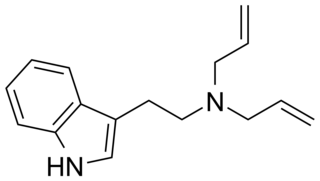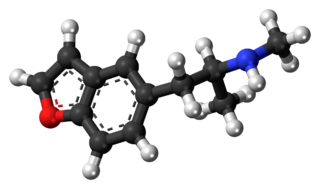
Dimethocaine, also known as DMC or larocaine, is a compound with a stimulatory effect. This effect resembles that of cocaine, although dimethocaine appears to be less potent. Just like cocaine, dimethocaine is addictive due to its stimulation of the reward pathway in the brain. However, dimethocaine is a legal cocaine replacement in some countries and is even listed by the European Monitoring Centre for Drugs and Drug Addiction (EMCDDA) under the category “synthetic cocaine derivatives”. The structure of dimethocaine, being a 4-aminobenzoic acid ester, resembles that of procaine. It is found as a white powder at room temperature.

25I-NBOMe is a novel synthetic psychoactive substance with strong hallucinogenic properties, synthesized in 2003 for research purposes. Since 2010, it has circulated in the recreational drug scene, often misrepresented as LSD. The recreational usage of 25I is associated with severe intoxication and deaths in humans.

3',4'-Methylenedioxy-α-pyrrolidinobutyrophenone (MDPBP) is a stimulant of the cathinone class developed in the 1960s, which has been reported as a novel designer drug. MDPBP is sometimes sold under the name "NRG-1" as a mixture with other cathinone derivatives, including flephedrone, pentylone, MαPPP and its higher homologue MDPV. As with other cathinones, MDPBP has been shown to have reinforcing effects in rats.

25B-NBOMe is a derivative of the phenethylamine psychedelic 2C-B, discovered in 2004 by Ralf Heim at the Free University of Berlin. It acts as a potent full agonist for the 5HT2A receptor. Anecdotal reports from users suggest 25B-NBOMe to be an active hallucinogen at a dose of as little as 250–500 µg, making it a similar potency to other phenethylamine derived hallucinogens such as Bromo-DragonFLY. Duration of effects lasts about 12–16 hours, although the parent compound is rapidly cleared from the blood when used in the radiolabeled form in tracer doses. Recently, Custodio et al (2019) evaluated the potential involvement of dysregulated dopaminergic system, neuroadaptation, and brain wave changes which may contribute to the rewarding and reinforcing properties of 25B-NBOMe in rodents.

N,N-Diallyltryptamine (DALT) is a tryptamine derivative which has been identified as a new psychoactive substance. It has been used as an intermediate in the preparation of radiolabeled diethyltryptamine.

25C-NBOMe is a psychedelic drug and derivative of the psychedelic phenethylamine 2C-C. 25C-NBOMe appeared on online vendor sites in 2010 but was not reported in the literature until 2011. It acts as a potent agonist of the 5HT2A receptor, and has been studied in its 11C radiolabelled form as a potential ligand for mapping the distribution of 5-HT2A receptors in the brain, using positron emission tomography (PET). Multiple deaths have occurred from usage of 25C-NBOMe due to the ease of accidental overdose. The long-term toxic effects of the drug have not been researched.

5-MAPB is an entactogenic designer drug similar to MDMA in its structure and effects.

6-MAPB is a psychedelic and entactogenic drug which is structurally related to 6-APB and MDMA. It is not known to have been widely sold as a "designer drug" but has been detected in analytical samples taken from individuals hospitalised after using drug combinations that included other benzofuran derivatives. 6-MAPB was banned in the UK in June 2013, along with 9 other related compounds which were thought to produce similar effects.

25D-NBOMe is a derivative of the phenethylamine derived hallucinogen 2C-D. It acts in a similar manner to related compounds such as 25I-NBOMe, which is a potent agonist at the 5HT2A receptor. 25D-NBOMe has been sold as a street drug since 2010 and produces similar effects in humans to related compounds such as 25I-NBOMe and 25C-NBOMe. It was banned as a Temporary Class Drug in the UK on 10 June 2013 after concerns about its recreational use.

25N-NBOMe is a derivative of the hallucinogen 2C-N. The pharmacological properties of 25N-NBOMe have not been described in the scientific literature, but it is believed to act in a similar manner to related compounds such as 25I-NBOMe and 25C-NBOMe, which are potent agonists at the 5HT2A receptor. 25N-NBOMe has been sold as a street drug and has only been described in the literature in terms of identification by forensic analysis.

25E-NBOMe is a derivative of the phenethylamine 2C-E. It acts in a similar manner to related compounds such as 25I-NBOMe, which are potent agonists at the 5HT2A receptor. 25E-NBOMe has been sold as a drug and produces similar effects in humans to related compounds such as 25I-NBOMe and 25C-NBOMe.

Ephenidine is a dissociative anesthetic that has been sold online as a designer drug. It is illegal in some countries as a structural isomer of the banned opioid drug lefetamine, but has been sold in countries where it is not yet banned.

The substituted benzofurans are a class of chemical compounds based on the heterocyclyc and polycyclic compound benzofuran. Many medicines use the benzofuran core as a scaffold, but most commonly the term is used to refer to the simpler compounds in this class which include numerous psychoactive drugs, including stimulants, psychedelics and empathogens. In general, these compounds have a benzofuran core to which a 2-aminoethyl group is attached, and combined with a range of other substituents. Some psychoactive derivatives from this family have been sold under the name Benzofury.

N-Ethylhexedrone (also known as α-ethylaminocaprophenone, N-ethylnorhexedrone, hexen, and NEH) is a stimulant of the cathinone class that acts as a norepinephrine–dopamine reuptake inhibitor (NDRI) with IC50 values of 0.0978 and 0.0467 μM, respectively. N-Ethylhexedrone was first mentioned in a series of patents by Boehringer Ingelheim in the 1960s which led to the development of the better-known drug methylenedioxypyrovalerone (MDPV). Since the mid-2010s, N-ethylhexedrone has been sold online as a designer drug. In 2018, N-ethylhexedrone was the second most common drug of the cathinone class to be identified in Drug Enforcement Administration seizures.

NPDPA is a dissociative anesthetic that has been sold online as a designer drug. It was first identified in Germany in 2008, and while it has never been as widely sold as related compounds such as diphenidine and ephenidine, it has continued to show up in seized drug samples occasionally, and was banned in Sweden in 2015.

The 25-NB (25x-NBx) series, sometimes alternatively referred to as the NBOMe compounds, is a family of serotonergic psychedelics. They are substituted phenethylamines and were derived from the 2C family. They act as selective agonists of the serotonin 5-HT2A receptor. The 25-NB family is unique relative to other classes of psychedelics in that they are, generally speaking, extremely potent and relatively selective for the 5-HT2A receptor. Use of NBOMe series drugs has caused many deaths and hospitalisations since the drugs popularisation in the 2010s. This is primarily due to their high potency, unpredictable pharmacokinetics, and sellers passing off the compounds in the series as LSD.

4-EA-NBOMe is a substituted amphetamine and 25-NB derivative which has been sold as a designer drug. It was first identified by a forensic laboratory in Germany in 2014, but while its analytical properties and metabolism have been studied, its pharmacology remains unknown.

25E-NBOH is a derivative of the phenethylamine derived hallucinogen 2C-E. It was first developed by Martin Hansen at the University of Copenhagen in 2010 as a brain imaging agent, but has subsequently been sold as a designer drug, first being identified in Brazil in 2018 on seized blotter paper, as well as in Slovenia. It acts as a potent serotonin receptor agonist with similar affinity to better-known compounds such as 25I-NBOMe at 5-HT2A and 5-HT2C receptors.

2C-E-FLY is a recreational designer drug with psychedelic effects. It is slightly less potent than 2C-E or 2C-B-FLY in animal studies but retains drug-appropriate responding.

25T7-NBOMe, is a substituted phenethylamine derivative from the 25-NB family. It acts as an agonist at the 5-HT2A and 5-HT2C serotonin receptors, has psychedelic effects and has been sold as a designer drug.




















